- Select Open in the File menu (or click on
 in the main Toolbar) to display the File Open box. Navigate to the Peranso Tutorials 4 folder. To do so, first locate your My Documents folder (typically C:\Users\<your_user_name>\Documents). In there is a subfolder Peranso, then select the subfolder Tutorials. Finally, select the folder 4. Finding multiple periods using CLEANest. Select the file RX Cap and click the Open button. This loads the contents of the file and creates an Observations Window (ObsWin) with caption "RX Cap (AAVSO Vis obs)", showing 1224 active observations obtained between JD 2,435,645 and JD 2,459,108. in the main Toolbar) to display the File Open box. Navigate to the Peranso Tutorials 4 folder. To do so, first locate your My Documents folder (typically C:\Users\<your_user_name>\Documents). In there is a subfolder Peranso, then select the subfolder Tutorials. Finally, select the folder 4. Finding multiple periods using CLEANest. Select the file RX Cap and click the Open button. This loads the contents of the file and creates an Observations Window (ObsWin) with caption "RX Cap (AAVSO Vis obs)", showing 1224 active observations obtained between JD 2,435,645 and JD 2,459,108.
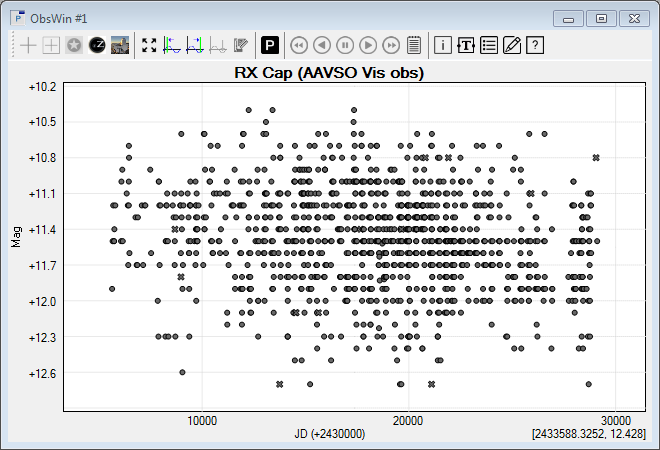
- Visual inspection of the light curve does not provide a conclusive picture, so let's do an initial broad search for periodicities to determine which values we should use as start and end values for the period search range. We will then narrow down the search range in step 3.
Click on the Period Determination button in the ObsWin toolbar to display the Period determination box. Select Time as Unit, enter 50 as start period (days) to search for, 500 as end period and 2500 as steps.
Select CLEANest (Foster) as method and then click the OK button. This creates a Period Window (PerWin), showing a complex spectrum with dominant peaks near 68 days, 140 days and 365 days. The latter clearly is an alias, and can be neglected.
- Based on this initial scan, we can now narrow down the search range from f.i. 50 days to 200 days. Close the PerWin we used for the broad search and create a new PerWin for the range from 50 - 200 days. This should result in:
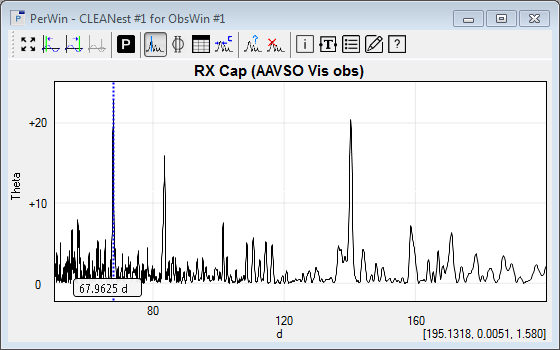
- The fact that there are multiple peaks in the PerWin is a first indicator that we might be dealing with a multi-periodic star. We will use the CLEANest Workbench tool to examine the light curve and search for periods. In this section of the tutorial we will discover the periods in an automated manner. In the next section, we will learn how to use the CLEANest Workbench to manually extract one period after the other.
- Select CLEANest Workbench in the Period analysis menu (or click on
 in the PerWin toolbar) to display the CLEANest Workbench. It consists of: in the PerWin toolbar) to display the CLEANest Workbench. It consists of:
- A tabular data grid, that we further refer to as the Peaks Table. The Peaks Table is similar to the Prominent Periods Table: whenever Peranso finds a frequency (or period) whose power level is higher than its neighbors (i.e., when it finds a ‘peak’), Peranso checks the power level to determine if this peak is one of the 20 best found so far. If so, it saves the relevant information (frequency, period, power level, etc.) in the Peaks Table.
- A section labeled Auto search, which we will use in step 6 of this tutorial.
- A section labeled Manual search with a series of buttons. We will use it further on in this tutorial.
- A section labeled Show/Hide, which we will explain below.
- Additional command buttons, explained elsewhere in this User guide.
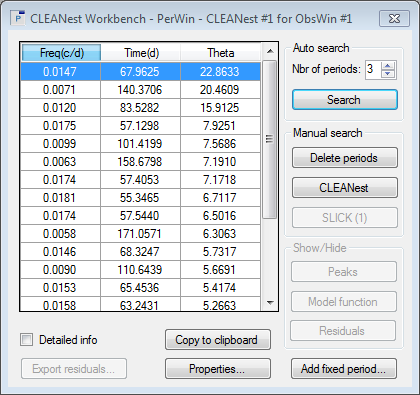
- To auto-search the RX Cap light curve for multiple periods, we simply have to enter the number of periods to search for, using the Nbr of periods selector in the Auto search section of the CLEANest Workbench tool. Select a value of 2 and click the Search button. Peranso will now start analysing the light curve and extract the periods. Depending on the number of observations in the light curve and the number of periods to search for, this can take a few seconds to a few minutes. A progress bar shows how far Peranso has proceeded with its calculations.
- Once completed, the two upper entries in the Peaks Table will color blue and they represent the two periods we searched for. We find values of 67.97 days and 140.37 days, in excellent agreement with the published values in John R. Percy's paper.
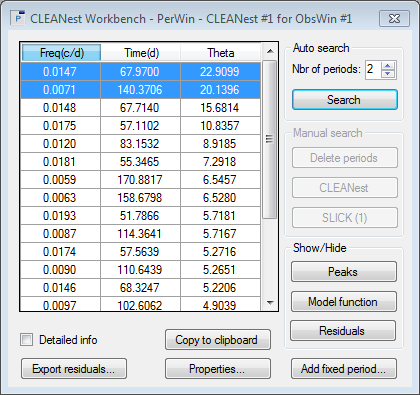
In addition, the PerWin is redrawn tho show the residual spectrum, i.e. the spectrum that remains after having subtracted the two periods from the initial power spectrum. On top of the residual spectrum, we notice two discrete spectrum peaks, at the above period values, drawn in blue color. The height of each spectrum peak corresponds with the CLEANest theta value of the peak. Click the Peaks button in the Show/Hide section to turn on/off these peaks.
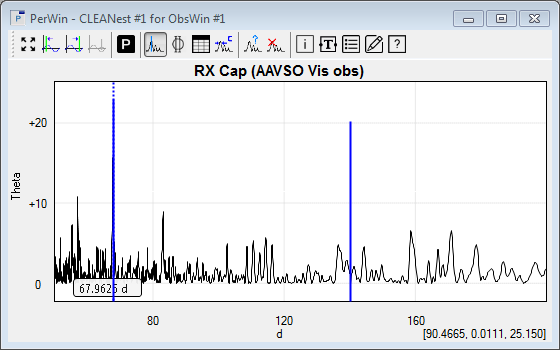
- To conclude, let's explore the Peaks table to determine if we should further look for a possible 3rd or 4th period in RX Cap. The third entry in the table shows a period at 67.71 days, which is nearly identical to the one of 67.97 days and therefore is not a true (new) period.
The fourth entry shows a period at 57.11 days. However, its power level of 11 is half of the power level of the two dominant peaks, and therefore no longer 'significant'.
We can safely conclude that RX Cap has two periods.
|